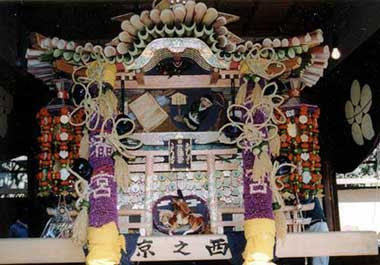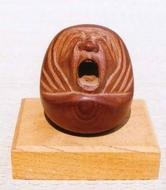:::::::::::::::::::::::::::::::::::::::::::::::::::::::::::::::::::::::::::::::::::::::::::::::::::::
Daruma Pilgrims Gallery
:::::::::::::::::::::::::::::::::::::::::::::::::::::::::::::::::::::::::::::::::::::::::::::::::::::
Muso Kokushi Soseki 夢窓 疎石(むそう そせき)
夢窓国師 Musoo Kokushi, Muso Kokushi
建治元年(1275) - 観応2年9月30日(1351, October 20))

妙智院. 重要文化財 夢窓疎石像 無等周位筆
Memorial Day for Muso : KIGO
Musoo-Ki 夢窓忌 (むそうき)
Soseki Ki 疎石忌(そせきき)
kigo for autumn
:::::::::::::::::::::::::::::::::::::::::::::::::::::::::::::::::::::::::::::::::::::::::::::::::::::
Musō Soseki (夢窓疎石) (1275 - October 20, 1351)
was a Rinzai Zen Buddhist monk and teacher, and a calligraphist, poet and garden designer. He is also known as Musō Kokushi (国師) ("national Zen teacher"), a posthumous name given him by Emperor Go-Daigo. His mother was the daughter of Hōjō Masamura.
Originally from Ise Province, now part of modern-day Mie Prefecture, Soseki was a ninth-generation descendant of Emperor Uda.
In 1325 Emperor Go-Daigo requested that he come to Kyoto to become head priest of the great temple of Nanzenji. The following year he founded Zen'o-ji in his native Ise.
Zen gardens have proven to be one of his most lasting contributions to his country's culture. To Musō designing new gardens and altering existing ones was an integral part of the practice of Zen.
Gardens by Musō Soseki

The following is a list of gardens known to be by Musō Soseki or attibuted to him.
Eiho-ji in Tajimi, Gifu prefecture
Erin-ji, in Yamanashi prefecture
Myōshin-ji in Kyoto
Rinsen-ji in Kyoto
Tenryū-ji in Kyoto
Tōnanzen-in in Kyoto
Enkaku-ji in Kamakura
Jōchi-ji in Kamakura
Zuisen-ji in Kamakura
© More in the WIKIPEDIA !
:::::::::::::::::::::::::::::::::::::::::::::::::::::::::::::::::::::::::::::::::::::::::::::::::::::
ZUIKI 随喜 to weep with joy

芋の葉に置く白露の
たまらぬは これやずいきの涙なるらん
imo no ha ni oku shiratsuyu no
tamaranu wa kore ya zuiki no namida naruran
This is a famous waka poem by Muso Kokushi, which gave the plant its name ZUIKI.
on the leaf of a taro
a white dewdrop lingers
and then falls off -
yes indeed this is
a tear of joy (of the Buddha)
zuiki, in a Buddhist context, means to feel joy at the joy of others and thus fill your own heart with their joy. In extension, it meand "tears of joy".
After many read this poem, they used this word ZUIKI to refer to the plant itself and its stem when they cook it.
zuiki 芋茎(ずいき)stem of the taro
Sato-Imo 里芋 taro
Originally it meant the leafstalk, petiole of the plant and used to be called imoshi いもし in the Heian period.
WASHOKU :
YASAI . Vegetable SAIJIKI
zuiki : Freudentränen vergießen
Zuiki matsuri ずいきまつり【芋茎祭/瑞饋祭】
Vegetable Decoration Festival
ずいき祭 , a kind of harvest thanksgiving festival
For four days from October 1 to 4 at the shrine Kitano Tenmangu in Kyoto.
 The festival is in memory of Sugawara Michizane菅原道真, the great the patron saint of scholarship, who is enshrined at Kitano Tenman-gu 北野天満宮. Michizane was a great scholar and statesman during the 9th century. He had carved a wooden image that is enshrined here. The festival originated when the people who lived around Kitano Tenman-gu had a very good harvest one year.
The festival is in memory of Sugawara Michizane菅原道真, the great the patron saint of scholarship, who is enshrined at Kitano Tenman-gu 北野天満宮. Michizane was a great scholar and statesman during the 9th century. He had carved a wooden image that is enshrined here. The festival originated when the people who lived around Kitano Tenman-gu had a very good harvest one year.Participants carry around portable shrines (mikoshi) on which the gods and spirits ride through the area. The roofs of the mikoshi are covered with the large leaves of taro and all are decorated with vegetables, called zuiki mikoshi ずいきみこし.
The festival started in the reign of Emperor Murakami (村上天皇 946-967), when the people supporting the shrine (神人(じんにん jinnin・じにん jinin) made offerings of their harvest. Later in 1527 they started to make figures out of vegetables and add them to a mikoshi. In the peaceful Edo period around 1607 they made even bigger portable shrines which looked like the round onion heads 葱華輦(そうかれん sookaren, soo 葱 is a long green onion with a round head), the roofs thatched with large taro leaves.
Since 1702 the mikoshi took the form of hooren 鳳輦(ほうれん) with a large phoenix (hoo) on the top. Since 1802 they took the form of chigi 千木(ちぎ) "like a palace with many roofs".
Since most of the material are fresh vegetables, the mikoshi are newly decorated every year.

Most used vegetables are
taro stalks and leaves, ears of rice, eggplants, chille peppers, yuzu citrons, sesame in white and black, bamboo, chestnuts, persimmons, myooga ginger, hair from corn, yuba tofu, fu gluten, nori, aonori and konbu seaweed and red and withe paper stripes.
:::::::::::::::::::::::::::::::::::::::::::::::::::::::::::::::::::::::::::::::::::::::::::::::::::::
Gardens by Kobori Enshu
Kobori Enshu 小堀遠州 (1579 - 1647)
Zen Garden Master Shunmyo Masuno 禅庭氏 増野さん
:::::::::::::::::::::::::::::::::::::::::::::::::::::::::::::::::::::::::::::::::::::::::::::::::::::
夢窓忌や谷の緑の錆びはじむ
Musoo-ki ya tani no midori no sabi-nijimu
Muso Memorial Day -
the green of the valley
begins to get rusty
Juuyoo 重陽
http://tourikadan.sakura.ne.jp/cgi-bin/html/hikou47.html
:::::::::::::::::::::::::::::::::::::::::::::::::::::::::::::::::::::::::::::::::::::::::::::::::::::
Daruma Pilgrims in Japan
O-Fudo Sama Gallery
:::::::::::::::::::::::::::::::::::::::::::::::::::::::::::::::::::::::::::::::::::::::::::::::::::::
[ . BACK to WORLDKIGO TOP . ]
:::::::::::::::::::::::::::::::::::::::::::::::::::::::::::::::::::::::::::::::::::::::::::::::::::::






2 comments:
I don't know Taro is Gabi in phlipin.
It is very interest fact.
Thank you Gabi san for sharing.
sakuo.
Kokushidake no Tengu-Iwa 国師岳の天狗岩 Tengu Rock
奥秩父 Oku-Chichibu
Mount Kokushidake is 2591 m high.
Near Kokushidake is the Tengu One 国師ヶ岳天狗尾根 "Tengu Mountain Ridge", with the Tengu Rock formation. In former times there was the Oku no In Mountain Shrine of 大岳山那賀都神社 Daidakesan Nagato Jinja from Yamanashi (former 三富村 Mitomimura). On top of the rocks is an iron sword, the ご神体 image of the deity.
The formation of the rocks is said to look just like the profile of a Tengu, with a long nose.
Mount Kokushidake was named after priest Musoo Kokushi 夢窓国師 Muso Kokushi.
Around 1330 Muso Kokushi stayed in Yamanashi, 塩山 Enzan at the temple 乾徳山恵林寺 Erin-Ji to make a temple garden (he was a specially gifted garden designer).
The mountain name 大岳山 Daidakesan (Oodakesan) also refers to him.
.
https://kappapedia.blogspot.jp/2017/06/tengu-from-chichibu.html
.
Post a Comment